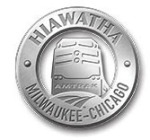
As Amtrak prepared to begin operations on May 1, 1971, dozens of communities across the country faced the loss of intercity rail passenger service because the trains serving them had not been chosen to operate under the Amtrak banner.
Among them were the Western Illinois cities of Quincy and Macomb, both of which were served by trains of Burlington Northern. Both cities were stops for the Chicago-North Kansas City American Royal Zephyr and unnamed Nos. 5/6 between Chicago and West Quincy, Missouri. Nos. 5/6 has once been known as the Kansas City Zephyr but was now known informally as the “Quincy Local.”
BN forerunner Chicago, Burlington & Quincy had sought to end the Kansas City Zephyr in late 1967 but 800 people, including 700 college students and their parents had opposed the move, leading the Interstate Commerce Commission to order the train to continue operating between Chicago and West Quincy. Students attending Western Illinois University in Macomb were heavy uses of Burlington passenger trains and the Burlington operated 24 specials a year to accommodate them.
Macomb had no airline service and no direct intercity bus service or interstate highway to Chicago, where many students were from. Quincy College also had a contingent of students from Chicago who took the train to campus.
With the “Quincy Local” set to make its final trips on April 30, 1971, officials of WIU, Quincy College, and the cities of Quincy and Macomb went to court on April 28, 1971, where Federal District Court Judge Joseph Sam Perry issued an injunction ordering BN to continue to operate the “Quincy Local.” The court vacated the injunction on May 10 and the “Quincy Local” was prompted discontinued.
But Quincy College and its allies weren’t through with their fight to preserve intercity rail passenger service to their communities. They filed suit In the U.S. District Court for the Northern District of Illinois, arguing that the Rail Passenger Service Act of 1970, which created the National Railroad Passenger Corporation, as Amtrak is formally known, was an unconstitutional attempt to regulate commerce that is solely intrastate.
A three-judge panel on June 21 disagreed and also rebuffed the argument of the plaintiffs that discontinuance of the “Quincy Local” violated section 403(b) of the 1970 Act, which authorized Amtrak to operate service beyond its initial basic route network if management thought it would be prudent to do so. The court’s decision was appealed and on Feb. 22, 1972, the U.S. Supreme Court upheld the decision of the District Court.
But even as Quincy College and its fellow plaintiffs were in court, legislation had been introduced in the Illinois General Assembly to appropriate $4 million to pay for service to Quincy and Macomb under section 403(b), which enabled state and local governments to request Amtrak service if they agreed to pay two-thirds of the operating deficit.
The bill was approved and the Illinois Zephyr began operating between Chicago and West Quincy, Missouri, on Nov. 4, 1971, with intermediate stops at LaGrange Road in the Chicago suburbs, Aurora, Mendota, Princeton, Kewanee, Galesburg and Macomb.
Service began at Plano on April 30, 1972, while Naperville replaced Aurora as a station stop on April 28, 1985. Service to Quincy proper began April 24, 1983. After flooding damaged the West Quincy station in July 1993, Quincy became the western terminus for the Illinois Zephyr on May 1, 1994.
Service on the Chicago-Quincy route expanded to two daily roundtrips on Oct. 30, 2006, with the inauguration of the Carl Sandburg. The Illinois Zephyr continued its traditional schedule of leaving Quincy in early morning and arriving in Chicago by 10:30 a.m. while departing Chicago in early evening for a 10 p.m. arrival in Quincy.
The Carl Sandburg, which was named for a Pulitzer Prize winning poet and biographer who had been born in Galesburg, was scheduled to depart Chicago at 8 a.m. and arrive in Quincy shortly after noon. The return trip to Chicago left Quincy in late afternoon and arrived in Chicago before 10 p.m.
As it marks its 50th anniversary, the Illinois Zephyr holds the distinction of being Amtrak’s continuously operated state-sponsored train. The Chicago-Quincy route is one of four Midwest corridor routes radiating from Chicago funded by the Illinois Department of Transportation. The other routes are Chicago-St. Louis; Chicago-Carbondale; and Chicago-Milwaukee, the latter funded in part by the Wisconsin Department of Transportation.











